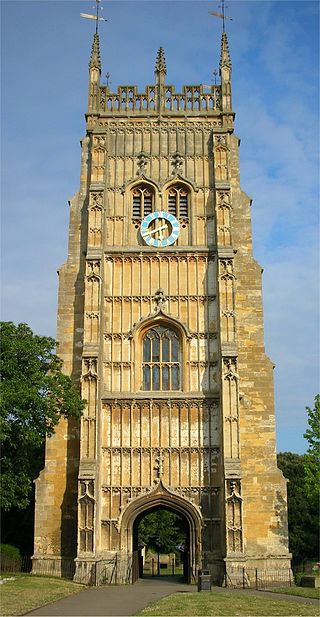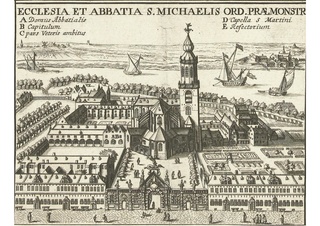Related Research Articles
William of Malmesbury was the foremost English historian of the 12th century. He has been ranked among the most talented English historians since Bede. Modern historian C. Warren Hollister described him as "a gifted historical scholar and an omnivorous reader, impressively well versed in the literature of classical, patristic, and earlier medieval times as well as in the writings of his own contemporaries. Indeed William may well have been the most learned man in twelfth-century Western Europe."

Evesham Abbey was founded by Saint Egwin at Evesham in Worcestershire, England between 700 and 710 following an alleged vision of the Virgin Mary by a swineherd by the name of Eof.
Henry of Huntingdon, the son of a canon in the diocese of Lincoln, was a 12th-century English historian and the author of Historia Anglorum, as "the most important Anglo-Norman historian to emerge from the secular clergy". He served as archdeacon of Huntingdon. The few details of Henry's life that are known originated from his own works and from a number of official records. He was brought up in the wealthy court of Robert Bloet of Lincoln, who became his patron.

The Roman Catholic Diocese of Condom was a French bishopric based in Condom from 1317 to 1801.
Petrus Comestor, also called Pierre le Mangeur, was a twelfth-century French theological writer and university teacher.
Matthew was a 12th-century churchman residing in Scotland. He is the first man known to have held the position of Archdeacon of St Andrews, his first known ecclesiastical post. He occurs in this office in a document which can be dated to some point between August 1147 and June 1152. Bishop Edward, Bishop of Aberdeen, died in 1172 and Archdeacon Matthew was elected as the successor. He was consecrated on 2 April 1172.
Odo Ydonc was a 13th-century Premonstratensian prelate. The first recorded appearance of Odo was when he witnessed a charter by Donnchadh, Earl of Carrick, on 21 July 1225. In this document he is already Abbot of Dercongal, incidentally the first Abbot of Dercongal to appear on record.
Trudpert Neugart was a Benedictine historian. Of middle-class origin, Neugart studied in the classical schools of the Benedictine Abbeys of St George and St. Blasien, entered the order at the latter monastery in l759, and was ordained priest 1765; in 1767 he was appointed professor of Biblical languages at the University of Freiburg. In 1770, however, he returned to St. Blasien where he professed theology.
Johann Friedrich Schannat was a German historian.
The Ancient Catholic Metropolitan Archdiocese of Laureacum (Lorch) existed in what is now northern Upper Austria. Lorch is 76 miles or 123 kilometers down the Danube to the east from Passau.

The Liber Eliensis is a 12th-century English chronicle and history, written in Latin. Composed in three books, it was written at Ely Abbey on the island of Ely in the fenlands of eastern Cambridgeshire. Ely Abbey became the cathedral of a newly formed bishopric in 1109. Traditionally the author of the anonymous work has been given as Richard or Thomas, two monks at Ely, one of whom, Richard, has been identified with an official of the monastery, but some historians hold that neither Richard nor Thomas was the author.
The Chronicon Abbatiae de Evesham or Chronicle of the Abbey of Evesham, sometimes the Evesham Chronicle, is a medieval chronicle written at and about Evesham Abbey in Worcestershire in western England.
Æthelwig was an Abbot of Evesham before and during the Norman Conquest of England. Born sometime around 1010 or 1015, he was elected abbot in 1058. Known for his legal expertise, he administered estates for Ealdred, the Bishop of Worcester prior to his election as abbot. After his election, he appears to have acted as Ealdred's deputy, and was considered as a possible successor when Ealdred was elected Archbishop of York. Æthelwig worked during his abbacy to recover estates that had been lost to Evesham, as well as acquiring more estates.
The Historia Ecclesie Abbendonensis or History of the Church of Abingdon was a medieval chronicle written at Abingdon Abbey in England in the 12th century. The Abbey was historically in the county of Berkshire, but since 1974 has been in the county of Oxfordshire.
Cambridge University Library, Ff. i.27 is a composite manuscript at the University of Cambridge. It was formed by adding a 14th-century Bury St Edmunds book to a compendium of material from 12th-century northern England. The latter compendium had once been part of Corpus Christi College Cambridge MS 66. With its original content, it had at one time been at Sawley Abbey, though it was probably produced somewhere else, perhaps Durham. It is a source for the Durham poem, which describes the city and its relics.

The Liebenau monastery was a Dominican monastery. It was located outside the city gates of Worms in today's Worms-Hochheim district.
The Pontifical Abbey of St Jerome-in-the-City was a Benedictine monastery in Rome founded in 1933 for the purpose of creating a critical edition of the Vulgate. The abbey was dissolved in 1984; their critical edition of the Vulgate is only that of the Old Testament, Catholic deuterocanonicals included, and is known as the Benedictine Vulgate.

St Michael's Abbey in Antwerp was a Premonstratensian abbey founded in 1124 by Norbert of Xanten and laid waste during the French Revolutionary Wars. In 1807 a semaphore station was installed in the tower of the church. The buildings were demolished in 1831.
The de Montfitchet family were of Norman origin, probably from the town of Montfiquet. Robert Gernon received manorial lands in Essex in reward for his service prior to publication of the Domesday Book in 1086, and his family were subsequently based there, initially in the castle at Stansted Mountfitchet. They lasted for five generations before becoming extinct when Richard de Montfichet died without issue in 1258. Other early attested spellings include Munfichet, Muntfichet, Montefixo, and Mufchet; while later variants include Mountfiquit and Montfiket.
William the Good was the count of Bordeaux in the final decades of the 10th century. The last recorded count of Bordeaux before him was Amalvinus, who flourished in the first decade of the century. Little is known of his rule, which may have been occupied by defence against Viking raids. On his death the County of Bordeaux passed to Duke William Sánchez of Gascony.
References
- ↑ Auguste Molinier, "1533. Chronicon sive historia abbatiae Condomensis", Les Sources de l'histoire de France—Des origines aux guerres d'Italie (1494), 2, 1 (1902), pp. 120–21.